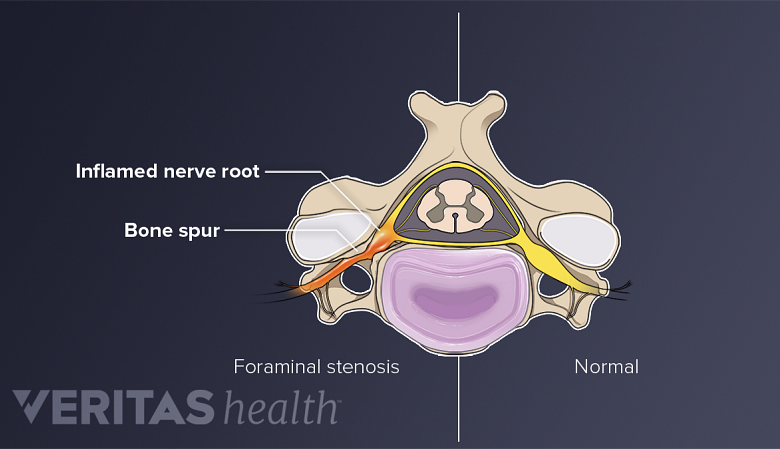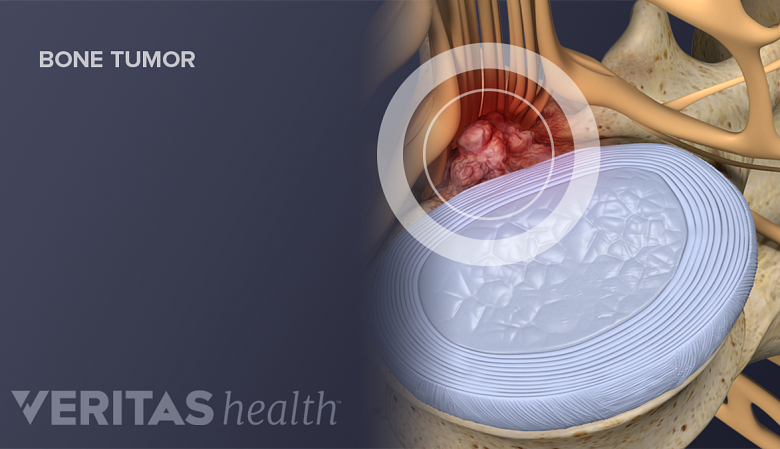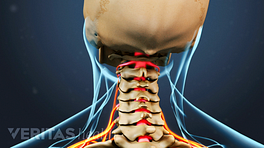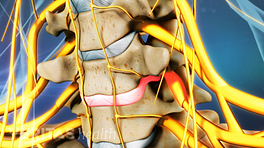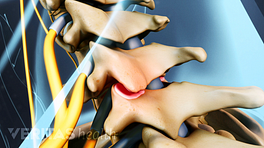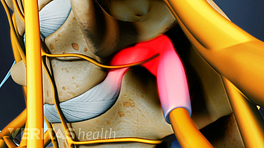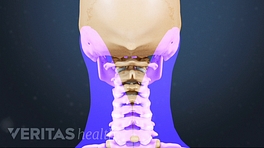Any condition that somehow compresses or irritates a cervical nerve root can cause cervical radiculopathy. It most commonly results from degenerative changes to the cervical spine over a longer period of time, but it can also occur due to an acute injury or illness.
In This Article:
- What Is Cervical Radiculopathy?
- Cervical Radiculopathy Causes and Risk Factors
- Cervical Radiculopathy Symptoms
- Diagnosing Cervical Radiculopathy
- Cervical Radiculopathy Treatment
- Cervical Radiculopathy Interactive Video
Common Causes of Cervical Radiculopathy
The two most common causes of cervical radiculopathy include:
Cervical foraminal stenosis
When a foramen (bony opening where a nerve root exits the spinal canal) narrows and becomes smaller, the nerve root has less space and may become impinged. Degenerative changes related to cervical osteoarthritis and/or cervical degenerative disc disease may result in nearby bone spurs (osteophytes), thickening ligaments, or a bulging disc that pushes against the nerve root in the foramen. Cervical foraminal stenosis is the most common cause of cervical radiculopathy.
Cervical herniated disc
If the inner material of the cervical disc leaks out and inflames or impinges the adjacent nerve, it can cause cervical radiculopathy. A herniated disc is more likely to occur from an injury or strenuous activity, which may explain why it is the most common cause of cervical radiculopathy in younger people (20s or 30s).
See Cervical Herniated Disc Symptoms and Treatment Options
Other cervical radiculopathy causes related to spinal instability or degeneration also exist.
Other Causes of Cervical Radiculopathy
Metastatic tumors may cause radiating pain depending on the site of the tumor.
While much less common, other potential causes of cervical radiculopathy include:
- Fracture. If part of a vertebra becomes fractured, the resulting instability or foraminal narrowing in the cervical spine may impinge a nerve root. Such a fracture could be caused by an injury or cervical spondylolisthesis (where one vertebra slips in front of another).
- Tumor. A tumor, whether malignant or benign, may grow nearby and push against a nerve root.
- Infection. Various spinal infections and—less commonly—systemic infections can lead to inflammation and/or damage to a nerve root.
- Sarcoidosis. A rare disease that can cause granulomas (lumps) to grow on any organ in the body.
Other conditions may also compress or cause damage to the cervical nerve root. It is also possible for a congenital anomaly to result in a narrowed foramen or other changes that increase the likelihood for cervical radiculopathy to develop.
Risk Factors for Cervical Radiculopathy
Heavy lifting can elevate the risk of cervical radiculopathy.
Some factors that may increase the risk for developing cervical radiculopathy include:
- Age. The risk for cervical radiculopathy tends to increase with age. Some estimates state that this risk peaks in a person’s 40s or 50s. 1 Iyer S, Kim HJ. Cervical radiculopathy. Curr Rev Musculoskelet Med. 2016; 9(3):272-80.
- Strenuous activities that are capable of putting high levels of stress on the cervical spine, such as wrestling or weight-lifting. 1 Iyer S, Kim HJ. Cervical radiculopathy. Curr Rev Musculoskelet Med. 2016; 9(3):272-80.
- Repetitive neck motions or vibrations, such as driving a truck (vibrating equipment) or repeatedly diving head first from a diving board into a pool. 1 Iyer S, Kim HJ. Cervical radiculopathy. Curr Rev Musculoskelet Med. 2016; 9(3):272-80.
Several other risk factors increase the risk for having cervical radiculopathy, such as smoking or previously having lumbar radiculopathy. 1 Iyer S, Kim HJ. Cervical radiculopathy. Curr Rev Musculoskelet Med. 2016; 9(3):272-80.
- 1 Iyer S, Kim HJ. Cervical radiculopathy. Curr Rev Musculoskelet Med. 2016; 9(3):272-80.
